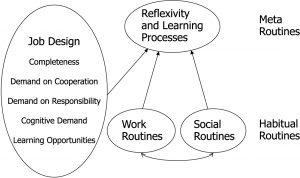Methods of Job Design- Job design means to decide the contents of a job. It fixes the duties and responsibilities of the job, the methods of doing the job and the relationships between the job holder (manager) and his superiors, subordinates and colleagues.

Job design also gives information about the qualifications required for doing the job and the reward (financial and non-financial benefits) for doing the job. Job design is mostly done for managers’ jobs. While designing the job, the needs of the organisation and the needs of the individual manager must be balanced. Needs of the organisation include high productivity, quality of work, etc. Needs of individual managers include job satisfaction. That is, they want the job to be interesting and challenging. Jobs must not be made highly specialised because they lead to boredom.
There are three main methods that organizations employ to create well-designed jobs. These are:
- Job Enlargement: This consists of adding to the scope of the job. Thus more tasks and duties are added to the existing job, usually at the same skills level resulting in more variety. Job enlargement can be seen as the opposite of specialization since it increases the scope of a person’s duties across a wider area. The objective of job enlargement is to motivate workers and avoid any boredom. An example of job enlargement would be when a receptionist in an organization is also given responsibility for data entering for the accounting department. Another example is when assembly line workers who typically work on only one piece of the production process are given the responsibility for building the entire product.
- Job Enrichment: This refers to adding an element of depth to the current job so that it becomes more satisfying to the employee. Job enrichment thus upgrades the responsibilities and scope of a job to make it more challenging. Job enrichment differs from job enlargement in that it is more than just increasing the range of tasks to be performed; it actually increases the responsibilities of the employee. Employees may take on responsibilities that were typically carried out by supervisors, and feedback is an integral part of the execution of the job in order to continuously assess and correct performance. Job enrichment aims to take the monotony out of performing jobs by inserting depth into a job and giving employees more control over how the job is done.
- Job Rotation: This method allows employees to rotate through different jobs in different departments in an effort to gain knowledge about how the organization operates. Job rotation does not have an effect on the design of any individual job; rather it allows an employee to perform different jobs in different parts of the organization with the aim of increasing the skills, experience and abilities of the employee. Job rotations can be extremely valuable when seen in the context of succession planning. For example, a high potential employee may be groomed through job rotations to take the place of an executive who may be retiring soon. Another instance when job rotations are used is in Leadership Development Programs where recently hired MBAs go through job rotations for a year or two and then choose a particular department after that period to work in a management capacity. Job rotation can be valuable methods of helping an employee find their strengths while also learning about the organization at a deep level.
Apply for Compensation and Benefits Certification Now!!
http://www.vskills.in/certification/Certified-Compensation-and-Benefits-Manager



